


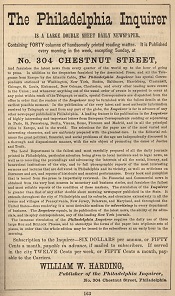


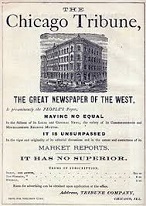
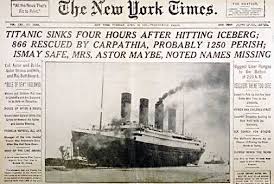








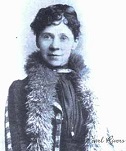



















TLW's Newspaperscope™ (Newspaper Historyscope) |
By T.L. Winslow (TLW), the Historyscoper™ |
© Copyright by T.L. Winslow. All Rights Reserved. |
Original Pub. Date: Feb. 7, 2018. Last Update: July 7, 2020. |
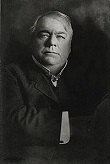
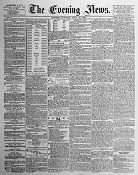
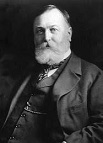
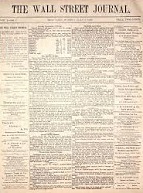

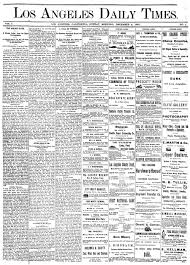



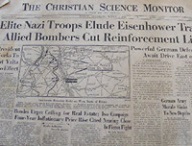

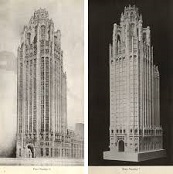
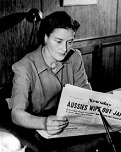





Westerners are not only known as history ignoramuses, but double dumbass history ignoramuses when it comes to newspapers and newspaper history. Since I'm the one-and-only Historyscoper (tm), let me quickly bring you up to speed before you dive into my Master Historyscope.
In 713 C.E. Kaiyuan Za (Chao) Bao (Bulletin of the Court) begin pub. for Chinese imperial officals, becoming the world's first newspaper/mag., consisting of news hand-printed on silk; it ceases pub. in 734.

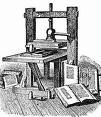
About 1439 German goldsmith Johannes Gutenberg (1398-1468) of Mainz invents a process for mass-producing movable type using a hand mold for a screw-type wooden Printing Press using oil-based ink; the Info. Explosion begins. Too bad, Bill Gates, er, the pope makes use of it to mass-produce indulgences to fill his coffers, fomenting a revolt in Germany led by Martin Luther.
In 1566 the first newspapers take the form of Avvisi (It. "advice", "announcement"), weekly handwritten news sheets folded to form four pages circulated in Venice, Italy, filled with news of politics and war; the first printed newspapers appear in Germany in 1605.
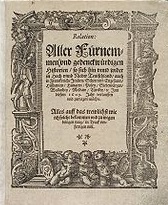
In 1605 Johann Carolus (1575-1634) begins pub. the German language Relation aller Fürnemmen und gedenckwürdigen Historien (Account of all Distinguished and Commemorable News) in Strasbourg, becoming the first newspaper; it is printed in quarto size with a single wide column of text.
On Mar. 11, 1702 England's first successful daily newspaper The Daily Courant begins pub. in London, run by Elizabeth Mallet of King's Arms Tavern in Fleet Bridge, London, who prints editorial-fee foreign news only on one side of the page, and advertisements on the other; it is soon acquired by Samuel Buckley at the Sign of the Dolphin in Little Britain, London; in 1735 it merges with the "Daily Gazetteer".
On Dec. 16, 1702 after an edict by Peter I the Great, the Moscow Gazette (Moskovskaya Vedomosti) newspaper begins pub. in Moscow, Russia, becoming Russia's first newspaper, pub. whenever he wants to blow his horn, moving to St. Petersburg in 1711 and reaching 4K circ., changing to the name "Sankt-Petersburgskie Vedomosti" in 1727 by the Russian Academy of Sciences after Big Peter's 1725 death, going biweekly; in 1914 it is renamed "Petrogradskie Vedomosti"; it ceases pub. in 1917.
On Aug. 8, 1703 the Weiner Zeitung (originally "Wiennerisches Diarium" until 1805) newspaper is founded in Vienna, Austria by the stonemasons building Stephans Dom; in 1810 it becomes the official newspaper of the govt., which acquires it in 1857 and sells it to a private co. in 1998, continuing to use it for official govt. announcements, with a circ. of 24K; becoming one of Austria's four main newspapers along with the right-liberal "Die Presse", the left-liberal "Die Standard", and the Roman Catholic "Salzburger Nachrichten".
In 1721 the New England Courant newspaper is founded in Boston, Mass. by Ben Franklin's older brother James Franklin (1697-1735) along with his wife Ann and brother Benjamin, introducing yellow journalism to Boston and forming the Hell-Fire Club, getting him imprisoned for four weeks in 1722 for "scandalous libel"; in 1727 the paper is suppressed, and he leaves Boston for Newport, R.I., founding Rhode Island's first printing press, followed in 1727 by the Rhode-Island Almanack AKA Poor Robin, and on Sept. 27, 1732 by the Rhode Island Gazette, which folds on May 24, 1733.
In 1725-1800 there are 137 newspapers pub. in N.Y. state, incl. 20 in New York City; by 1865 there are 373 newspapers being pub. in 428 eds. in N.Y., incl. 54 in New York City.
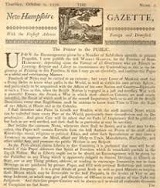
On Oct. 7, 1756 The New Hampshire Gazette is founded in Portsmouth, N.H. by printer Daniel Fowle (1715-87), becoming the first newspaper in N.H.; in 1839 after the Maryland Gazette ceases pub., it is recognized as the oldest newspaper in the U.S., causing it to trademark the phrase "The Nation's Oldest Newspaper".

On Oct. 29, 1764 the weekly Hartford Courant (originally "The Connecticut Courant") is founded by Thomas Green; in 1776 at the start of the Am. Rev. it is the most popular newspaper in the U.S., although pamphlets get far more circulation, of which most are church sermons; it goes daily in 1837; in 1980 it is acquired by the Times Mirror chain, which is acquired by the Tribune Corp.; the newspaper goes on to adopt the slogan "Older than the nation", and "America's oldest continously published newspaper".
The Am. Rev. really starts with fifth column propaganda in England? On Jan. 21, 1769 the anon. Letters of Junius begin to be pub. in the Public Advertiser in London (until Jan. 21, 1772), attacking corruption in public men, warning of the dangers of arbitrary power, and praising the virtues of a shorter term for Parliament; they are addressed to Sir William Draper, the Duke of Grafton, the Duke of Bedford et al.; in 1812 John Taylor claims that the real Junius is Sir Philip Francis, and in 1872 Joel Moody claims that he is Thomas Paine; it's really Benjamin Franklin (1706-90), who is also in London at the time?; the printers and publishers are tried for seditious libel, found guilty, then cleared after a 2nd trial, making them more popular, and in 1772 all 69 letters are reprinted by the Public Advertiser of London, owned by Henry Sampson Woodfall (1739-1805); "The liberty of the press is the palladium of all the civil, political, and religious rights of an Englishman"; "The submission of free people to the executive authority of government, is no more than a compliance with laws which they themselves have enacted"; "One precedent creates another. They soon accumulate and constitute law. What yesterday was fact, today is doctrine"; "We owe it to our ancestors to preserve entire those rights, which they have delivered to our care: we owe it to our posterity, not to suffer their dearest inheritance to be destroyed"; "I believe there is yet a spirit of resistance in this country, which will not submit to be oppressed; but I am sure there is a fund of good sense in this country, which cannot be deceived"; "[Americans] equally detest the pageantry of a king, and the supercilious hypocrisy of a bishop"; "There is a holy mistaken zeal in politics as well as in religion. By persuading others, we convince ourselves."

In 1770 the anti-British newspaper Mass. Spy is founded in Boston, Mass. by Isaiah Thomas (1749-1831), who helps Paul Revere in his midnight ride in 1775.

On Jan. 12, 1780 the German-language daily newspaper Neue Zuercher (Zürcher) Zeitung is founded in Zurich, Switzerland by Swiss painter-poet-bookseller Salomon Gessner (1730-88), raising the bar in journalistic objectivity and depth incl. coverage of music and theater as well as an advertising section, becoming the Swiss newspaper of record, with circ. reaching 18K in 1910, 47.5K in 1930, and 66.6K in 1950, peaking at 169K in 2000.
On Mar. 26, 1780 the E. Johnson's British Gazette and Sunday Monitor begins pub. in London (until Sept. 22, 1805), becoming the first Sunday newspaper in Britain - extra, extra, read all about it, we're not losing but not winning in America?


On Jan. 1, 1785 John Walter (1739-1812) founds The Daily Universal Register in London, England, concentrating on ads in competition with eight other newspapers; on Jan. 1, 1788 he changes its name to The Times, and branches into scandals and gossip whiile striving to record the views of the London elite, launching a trend of naming newspapers some variant of Times; Times Roman typeface is developed to be legible despite low-tech printing, switching in Nov. 2006 to Times Modern; in 2004 it switches from broadsheet to compact formats, escept The Sunday Times; in Dec. 2016 it has a daily circ. of 446K, 792K for The Sunday Times; on June 6, 2006 it launches a U.S. ed.; it becomes a favorite of libraries, with its detailed index insuring popularity with researchers.
In 1785 The Augusta Chronicle weekly newspaper is founded in Augusta, Ga., becoming known for coverage of the Masters Tournament, reaching a modern-day circ. of 55K daily and 71K Sun.; on Aug. 9, 2017 it is announced that it will be sold to GateHouse Media along with 10 other daily newspapers for $120M.
In 1785 the Poughkeepsie Journal is founded in Dutchess County, Poughkeepsie, N.Y.; in 1788 its ed. becomes the official reporter of the ratification of the U.S. Constitution; during the Franklin D. Roosevelt admin. it serves as the launchpoint for stories by FDR from his estate in nearby Hyde Park; it goes on to become the oldest paper in N.Y.

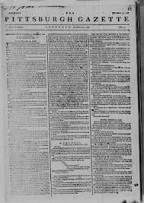
On July 29, 1786 the Pittsburgh Post-Gazette (originally the "Pittsburgh Gazette") is founded in Pittsburgh, Penn. by Joseph Hall and John Scull (1765-1828), becoming the first U.S. newspaper pub. W of the Allegheny Mts., starting out by pub. the new U.S. Constitution; in 1829-41 Neville Burgoyne Craig (1787-1863) becomes ed., backing the Anti-Masonic movement, turning it into an afternoon daily on July 30, 1833, then switching to morning in 1844 ater merging with the "Pittsburgh Post" (founded Sept. 10, 1842), backing the Whig Party before switching in the 1850s to the new Repub. Party., becoming one of the first papers to suggest that a civil war is coming; it goes on to win four Pulitzer Prizes, reaching a modern-day circ. of 173K daily and 317K on Sun.
On Sept. 6, 1786 the Daily Hampshire Gazette is founded in Northampton, Mass. starting out with coverage of Shays' Rebellion.

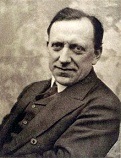

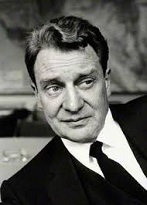
On Dec. 4, 1791 The Observer Sun. broadsheet newspaper is founded in London, England by W.S. Bourne, becoming the world's first Sun. newspaper; too bad, he goes bankrupt and sells it to his brother, who gets govt. backing in return for influence over ed. content, going on to preach against Thomas Paine, Francis Burdett, Joseph Priestley et al.; in 1901 it is acquired by Lord Northcliffe, who sells it in 1911 to William Waldorf Astor, who gives it to his son Waldorf Astor, 2nd Viscount Astor (1879-1952) in 1915, with Conservative ed. (since 1908) James Louis Garvin boosting circ. to 200K by 1942 when he is forced out by Waldorf's liberal son David (Francis David Langhorne) Astor (1912-2001), who becomes ed. in 1948-75, going on to oppose the 1956 govt. invasion of Suez, which causes circ. to tank, after which the Astors sell it to Atlantic Richfield (ARC), who sells it to Lonrho plc in 1981, who sells it to Guardian Media Group in June 1993.

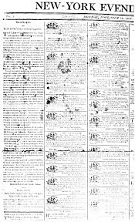
On Nov. 16, 1801 after getting pissed-off at the election of Dem.-Repub. Party leader Thomas Jefferson (1743-1826), the tabloid newspaper New York Post (originally New-York Evening Post) is founded in New York City by Founding Father Alexander Hamilton (1755-1804) and other Federalists with $10K "to inculcate just principles in religion, morals and politics", becoming the oldest daily newspaper in the U.S. to survive to modern times, with a modern-day circ. of 500K.

In Jan. 1802 after his first newspaper The Porcupine fails in 1801, crusading pamphleteer William Cobbett (1763-1835) founds Cobbett's Weekly Political Register, which is so radical that in 1815 the govt. attempts to er, stamp it out by imposing a 4d stamp duty on all newspapers, which he counters in Nov. 1816 by pub. a cheap (2d) pamphlet ed. sans news, becoming known as "tuppenny trash", reaching a circ. of 40K; he also pub. Parliamentary Debates, an exact record of Parliamentary debates, which is illegal but doesn't stop him, selling it to T.C. Hansard in 1812; the Political Register is pub. weekly until the the year after his death. In 1807 Cobbett coins the term "red herring" for strong smelling smoked kippers used to lay a false trail for hunting dogs.



On July 23, 1803 the Society of United Irishmen, led by Robert Emmet (1778-1803) stage the diastrous Irish Insurrection (Rebellion) of 1803 in Dublin, which is suppressed by English CIC in Ireland gen. Henry Edward Fox (1755-1811) (son of Baron Henry Fox, who got rich as paymaster gen. in the Seven Years' War); on Sept. 20 after telling his judges "Let no man write my epitaph", Emmett is hanged, drawn and quartered in the new Kilmainham Gaol (built 1796) in Dublin, which becomes infamous for maltreatment of prisoners, with men, women, and children not segregated and forced to live most of the time in the dark; more Irish are transported from Spike Island Prison in beautiful Cork harbor to Botany Bay to face cruel Gov. Captain William Bligh of "Mutiny on the Bounty" fame, incl. Michael Dwyer (1772-1825) of County Wicklow and his comrades Hugh Byrne, Martin Bourke and Arthur Devlin; at least the first Roman Catholic masses are permitted there by the "No Popery" Brits on the site of the future (1844) Church of St. Patrick in Sydney.

On Aug. 14, 1810 Isaiah Thomas (1749-1831) of Worcester, Mass. pub. The History of Printing in America, with a Biography of Printers, and an Account of Newspapers (2 vols.), which becomes a std. work; 2nd ed. 1874.
In 1818 the non-conformist Liberal Manchester Observer newspaper is founded in Manchester, England to push a radical pro-labor agenda of reallocating rotten and closed borough Parliamentary seats to industrial towns incl. Manchester; it is closed by the govt. in 1821.

On Aug. 16, 1819 60K-100K demonstrate against the Corn Laws at St. Peter's Field (Square) outside Manchester, England, and after a radical speech by Henry "Orator" Hunt (1773-1835) are charged by cavalrymen with sabers, killing 18 and injuring 650 incl. 100+ women and children, becoming known as the Peterloo Massacre, named after the Battle of Waterloo by James Wroe, whose radical newspaper The Manchester Observer is closed down in 1821 while he is given 1 year in jail for seditious libel after the British govt. responds on Nov. 23 with the 666, er, Six Acts, clamping down on "radical" parties (the first time the word is used of a political party in England) and newspapers, and potential armed uprisings, causing 28-y.-o. witness John Edward Taylor to launch his own newspaper The Manchester Guardian in 1821; Hunt gets two years in prison, becoming a bigger celeb but refusing to approve armed revolt - don't forget to order a side of wings with all your Party Hut orders?
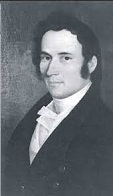
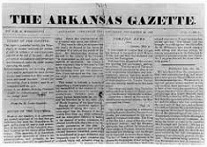
On Nov. 20, 1819 the Arkansas Democrat-Gazette (originally the "Arkansas Gazette" until 1850) is founded in Arkansas Post, Ark. by Long Island, N.Y.-born William Edward Woodruff (1795-1885), who moves the HQ to Little Rock in 1821 and leads the campaign for Ark. statehood (1836); it goes on to claim to be the oldest continuously published newspaper W of the Mississippi River, reaching a modern-day circ. of 192K daily and 284K Sun.
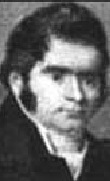
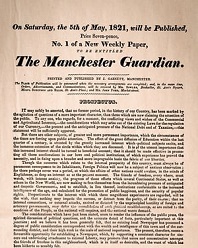
On May 5, 1821 after the 1819 Peterloo Massacre causes them to see their chance, the weekly Manchester Guardian newspaper (sometimes called The Grauniad because of its frequent typos) is founded in Manchester, England by cotton merchant John Edward Taylor (1791-1844), whose mother Mary worked with Anna Seward to pub. "The Female Advocate" in 1774, gaining backing from the Little Circle of non-conformist pro-industrial town Liberal businessmen, gaining a rep for being on the side of mill owners against labor; it goes daily in 1855, dropping "Manchester" from the title in 1959; in 1936 the Scott Trust Ltd. is created "to secure the financial and editorial independence of the Guardian in perpetuity and to safeguard the journalistic freedom and liberal values of the Guardian free from commercial or political interference"; in 2016 the print ed. reaches 162K circ.; in 2018 it change to a tabloid format.
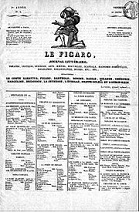
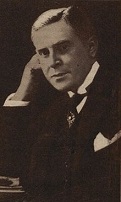
On Jan. 15, 1826 Le Figaro satirical weekly newspaper is founded in Paris, France, named after the 1778 Pierre Beaumarchais play, with the motto "Without the freedom to criticize, there is no true praise"; on Nov. 16, 1866 it becomes a daily newspaper, with a circ. of 56K copies, highest in France, and a royalist ed. line; in 1922 it is purchased by Corsican-born French perfume magnate Francois Coty (Joseph Marie Francois Spoturno) (1874-1934) (relative of Napoleon Bonaparte); by WWII it becomes France's #1 newspaper, going on to become the conservative voice of the upper middle class and one of two French newspapers of record after Le Monde, reaching a modern-day circ. of 313K.
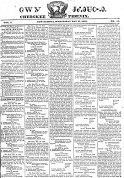
On Feb. 21, 1828 the first issue of the bilingual Cherokee Phoenix is pub. in New Echota (modern-day Ga.) (until 1834), becoming the first newspaper pub. by Native Ams., and first pub. in a Native Am. language, containing the Constitution of the Cherokee Nation and claiming that their lands in N Georgia and W Carolina are "solemnly guaranteed and reserved forever to the Cherokee Nation by the Treaties concluded with the United States" (Treaty of 1791, et al.); Georgia responds with a law stipulating that after June 1, 1830 the authority of state law will extend over all Cherokees living within their state boundaries; the newspaper ceases pub. in 1834.


On June 1, 1829 The Philadelphia Inquirer is founded in Philadelphia, Penn. by John Norvell (1789-1850) and John R. Walker, who sell it in Nov. to Jesper Harding (1799-1865), who merges it with the Daily Courier and obtains the first U.S. rights to several of Charles Dickens' novels incl. "Barnaby Rudge" and "Master Humphrey's Clock" and renames it "The Pennsylvania Inquirer and National Gazette" in 1845 before passing it to his son William White Harding in 1859, who increases circ. from 7K to 70K by 1863 before selling-out to British-born James Ellerson in 1889; the newspaper starts out supporting the Dem. Party then switching to the Whig Party and Repub. Party before going nonpartisan in the 1950s; in 1936-69 it is owned by the Annenberg family, who sells it to Knight Newspapers, by which time it trails its rival the "Philadelphia Evening Bulletin", but in the 1970s new owners hire new eds. and turn it into a top newspaper that wins 20 Pulitzer Prizes, with Time mag. listing it in the top-10 daily newspapers of 1984, becoming the 3rd oldest surviving daily newspaper in the U.S.
In 1829 The Providence Journal (ProJo) is founded in Providence, R.I. by "Honest" John Miller, later billing itself as "America's oldest daily newspaper in continuous publication" after "The Hartford Courant" (founded 1764) doesn't become a daily until 1837, and "The New York Post" suspends pub. during the newspaper strikes of 1958 and 1978.
In 1830 the weekly newspaper The Barnstable Patriot is founded in Barnstable, Mass., going on to bill itself as "an independent voice since 1830".
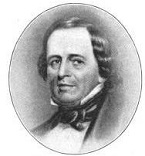
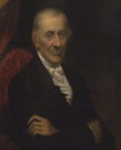
On May 5, 1831 the Detroit Free Press (originally Dem. Free Press and Mich. Intelligencer until 1835) is founded in Detroit, Mich. by Detroit mayor #1 (since 1824) John R. Williams (1782-1854) and his uncle Joseph Campau (1769-1863), becoming a backer of the Dem. Party; in 1940 it is acquired by the Knight Newspapers (Knight Ridder), becoming a morning newspaper competing with the evening The Detroit News; it goes on to win 10 Pulitzer Prizes and promote the motto "On Guard for 186 Years" (2017).
In 1832 The Star-Ledger (originally the "Newark Daily Advertiser", then the "Newark Star-Eagle") is founded in Newark, N.J., becoming the largest newspaper in N.J., reaching a modern-day circ. of 114K daily and 359K on Sun.


On May 6, 1835 the New York Herald newspaper (four pages for a penny), ed. by Scottish-born James Gordon Bennett Sr. (1795-1872) begins pub. in the cellar of #20 Wall St. in New York City, going on to print the first Wall Street financial article and report the first political speech in full, that of John Calhoun on the Mexican War, received by telegraph, making use sensationalism to become the #1 newspaper in the U.S. by 1845, reaching 84K circ. in 1861 before he turns the paper over to his son James Gordon Bennett Jr. in 1866; it ceases pub. in 1924, becoming the namesake of Herald Square (S of Times Square), and acknowledged in the 1904 song "Give My Regards to Broadway" ("Remember me to Herald Square").
In 1835 there are 1.2K newspapers and penny press pubs. in the U.S.
On May 11, 1836 the Du Buque Visitor, the first newspaper in Iowa begins pub.


On Jan. 25, 1837 The Times-Picayune (originally The Picayune) newspaper is founded in New Orleans, La. by George Wilkins Kendall (1809-67) et al.; the initial price is one Spanish picayune (half a bit); in 1876 Eliza Jane Nicholson (Holbrook) (nee Poitevent) (1843-96) AKA Pearl Rivers inherits the paper from her hubby, introducing Society Bee columns, children's pages, and the first women's advice column, written by Dorothy Dix, tripling circ. between 1880 and 1890; in 1914 it becomes "The Times Picayune" after merging with the "New Orleans Times Democrat"; it goes on to win the 2006 Pulitzer Prize for its coverage of Hurricane Katrina.


In 1841 Amherst, N.H.-born Horace Greeley (1811-72) founds the New-York Tribune (New-York Daily Tribune until 1866) as a "Great Moral Organ" for Whigs, positioning it between the sensational New York Herald and the academically detached New York Evening Post, writing against unequal distribution of wealth, monopolies, and land grabs by railroads, while promoting protective tariffs, development of agriculture, and migration to the Am. West; in 1852-62 Karl Marx is hired as their London-based European correspondent, with his collaborator Friedrich Engels allowed to submit articles under his byline; it ceases pub. in 1966.

In 1842 the (Cleveland) Plain Dealer newspaper is founded in Cleveland, Ohio.
On May 22, 1846 the New York News Agency is founded by Hale and Burnett after six newspapers decide to combine to share telegraphy costs; in 1856 it becomes the Associated Press (AP), going on to be carried by 1.7K newspapers and 5K TV and radio stations by 2007, and operate 200 news bureaus in 100 countries along with a photo library containing 10M images; in 1993 it passes its rival UPI.

On June 10, 1847 the Chicago Tribune is founded in Chicago, Ill. by James Kelly (1809-95) et al., billing itself as "the Great Newspaper of the West", and "World's Greatest Newspaper", going on to support the Free Soil and Whig parties against the Dems. and promoting xenophobia against foreigners esp. Roman Catholics, affiliating with the Know Nothing Pary on Feb. 10, 1855, also supporting temperance, becoming the #1 paper in the Chicago metro and Great Lakes region; until ? the masthead displays the U.S. flag along with the motto "An American Paper for Americans".
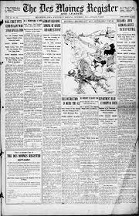
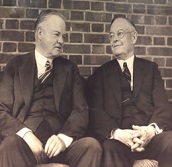
In 1849 the Iowa Star is founded, becoming the first newspaper in Des Moines; in 1855 The Des Moines Register (originally the "Iowa Citizen") begins pub., becoming the "Iowa State Register" in 1860; in 1902 it merges with the Des Moines Leader, becoming the Des Moines Register and Leader; in 1903 it is purchased by Des Moines banker and Repub. politician Gardner Cowles Sr. (1861-1946), who renames it "The Des Moines Register" in 1915 after acquiring the evening Des Moines Tribune in 1908, which he merges with the Des Moines News in 1924 and Des Moines Capital in 1927, ceasing pub. on Sept. 25, 1982; in 1943 the Register becomes the first newspaper to sponsor a statewide opinion poll, the Iowa Poll; on Aug. 26, 1973 it sponsors the first non-competitive Register's Annual Great Bicycle Ride Across Iowa (RAGBRAI), becoming the largest bike touring event on Earth.
On June 20, 1851 the San Jose Mercury News (originally the "San Jose Weekly Visitor" until 1883, then the "San Jose News") is founded in San Jose, Calif.; in 1942 the "Mercury" acquires it, merging in 1983, soon discontinuing its afternoon ed., becoming a key chronicler of the rise of the computer industry in Silicon Valley; in 1952 it is acquired by Ridder, which merges with Knight in 1974 to form Knight-Ridder, which is acquired on Mar. 13, 2006 by the McClatchy Co., which renames it "The Mercury News"; in 2016 the "San Mateo County Times" merges with it.






On Sept. 18, 1851 the 1-cent The New York Times (NYT) (originally the New-York Daily Times until Sept. 14, 1857, and the New-York Times until Dec. 1, 1896)) newspaper begins pub., ed. by Henry Jarvis Raymond (1820-69), who goes on to become an Abe Lincoln supporter; on Apr. 21, 1861 it begins pub. a Sun. ed.; "We shall be Conservative, in all cases where we think Conservatism essential to the public good; - and we shall be Radical in everything which may seem to us to require radical treatment and radical reform. We do not believe that everything in Society is either exactly right or exactly wrong; - what is good we desire to preserve and improve; - what is evil, to exterminate, or reform"; in 1896 it is purchased by Jewish publisher Adolph Simon Ochs (1858-1935), who coins the slogan "All the News That's Fit to Print", and passes it to his son Arthur Hays Sulzberger (1891-1968), who passes it to his son Arthur Ochs "Punch" Sulzberger Sr. (1926-2012), who passes it to his son Arthur Ochs Sulzberger Jr. (1951-); a Sept. 17, 1951 Life article titled The Gray Lady Reaches 100 first calls it the Gray Lady; too bad, by the late 20th cent. its editorial board goes leftist, churning out fake news by the ton, esp. during the Pres. Trump era, with Thomas Sowell uttering the soundbyte: "The New York Times' long-standing motto 'All the News That's Fit to Print" should be changed to reflect today's reality: 'Manufacturing News to Fit an Ideology'."
In 1851 The Golden Hills News, the first Asian-Am. newspaper begins pub. in San Francisco, Calif.

In 1851 Reuter News Agency (Reuters) is founded by German Jew Baron Paul Julius von Reuter (1816-99) (born Israel Beer Josaphat) in Kassel, Germany, who went into the news agency biz in 1849 at Aachen, sending news to Verviers, Belgium, where the French and Belgium telegraph lines end; the service starts by dispatching telegrams by rail and pigeon post to places unreachable by telegraph, then begins employing news-gathering agents throughout Europe, finally going bigtime in 1858 when the London Times signs up, causing Reuter to become a British citizen and receive the title of baron in 1871 from the Duke of Saxe-Coburg-Gotha - the origin of the Jews control the media conspiracy theory?
Spirit genocide, or This is how a heart breaks? In 1855 English-born Dr. Isaiah Deck of New York City proposes using recycled Egyptian mummies for newspaper; in 1860 Augustus Stanwood of Gardiner, Maine uses them to manufacture heavy brown wrapping paper for meat; they are also used to fuel railroad engines - Denial is a river in Egypt?
On July 2, 1856 The Honolulu Advertiser (originally "The Pacific Commercial Advertiser") is founded in Honolulu, Hawaii by Henry M. Whitney as a weekly newspaper, becoming the largest daily newspaper in Hawaii; it ceases pub. on June 6, 2010, merging with the "Honolulu Star-Bulletin" to become the Honolulu Star-Advertiser, reaching a modern-day circ. of 209K daily and 164K Sun.

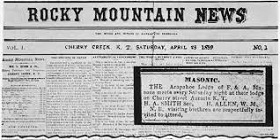
On Apr. 23, 1859 Ohio-born William Newton Byers (1831-1903), who arrived in Denver, Colo. from Omaha, Neb. (which he co-founded) with printing equipment from the defunct Bellevue Gazette pub. the first issue of the Rocky Mountain News (first newspaper in the territory) out of a room above Dick Wooten's Saloon on the banks of Cherry Creek; it comes out 20 min. ahead of the rival Cherry Creek Pioneer and is delivered by oxcart; in Aug. 1860 it goes from weekly to daily; in July 1870 it goes from an evening to a morning newspaper; in 1926 it is acquired by the E.W. Scripps Co., competing with the evening The Denver Post, and almost going bankrupt when new editor Jack Foster changes it from a broadsheet to tabloid format; Foster's wife Frances Foster founds Molly Mayfield, the first advice column in the U.S. in 2001 it merges with The Denver Post to form the Denver Newspaper Agency; on Jan. 23, 2007 it is redesigned into a smaller mag.-style format with more color; it pub. its last issue on Feb. 27, 2009.
In 1860 the New York World begins pub. (until 1931), becoming the voice of the Dem. Party; in 1883 it is acquired by Joseph Pulitzer, who plunges it into yellow journalism, raising circ. to 1M, hiring Nellie Bly, who pioneers investigative journalism, and repeats Jules Verne's 1873 novel "Around the World in Eighty Days" in 72 days in 1889-90; in 1890 the New York World Bldg. is built, becoming the world's tallest office bldg.; in 1896 it becomes the first newspaper with a color supplement.
In 1861 Detroit Free Press pub. Wilbur F. Storey sends correspondents to Washington, D.C. and the battlefields at the outbreak of hostilities in Apr., buys the 7-y.o. Daily Chicago Times from reaper man Cyrus H. McCormick on June 8, renames it the Chicago Daily Times on June 20, and declares in an editorial "It is a newspaper's duty to print the news and raise hell", sticking to the paper's pro-war Dem. Party bias; in 1948 it merges with the Chicago Sun to become the Chicago Sun-Times.
On Jan. 15, 1863 the Boston Morning Herald becomes the first U.S. newspaper to be printed on paper made from wood pulp instead of hemp.
On Dec. 10, 1863 the Seattle Post-Intelligencer (originally the "Seattle Gazette") daily broadsheet newspaper is founded in Seattle, Wash., soon folding and becoming the "Weekly Intelligencer", owned by Sam Maxwell; in 1878 it becomes a morning daily owned by Thaddeus Hanford (1847-92), who merges it with the daily "Puget Sound Dispatch" and the weekly "Pacific Tribune"; in 1886 it is acquired by Ind. businessman Leigh S. J. Hunt (1855-1933), who sells-out after the Panic of 1893; in 1911 circ. reaches 31K; in 1921 it is taken over by guess-who William Randolph Hearst; becoming the rival of "The Seattle Times" until it goes online-only on Mar. 18, 2009.





On June 12, 1865 "Monarch of the Dailies" The San Francisco Examiner (originally "The Daily Examiner") in rip-roaring get-rich-quick San Francisco, Calif. begins pub. after being founded in 1863 as the pro-Confed. newspaper "The Democratic Express" by brothers Michael H. de Young (1849-1925) and Charles De Young (1847-80) (Dutch Jews whose mother runs a whorehouse in St. Louis?) after borrowing a $20 gold piece from their landlord to pub. a theater program sheet, and was destroyed by a mob after Pres. Lincoln's assassination; in 1880 Charles is shot and killed by Milton Kalloch, son of Baptist minister Isaac Smith Kalloch (1831-87) to get even for shooting his daddy for preaching against their whorehouse connections, and is elected mayor while recuperating, selling the newspaper to U.S. Sen. George Hearst to pay a poker debt, who in 1887 gives it to his son William Randolph Hearst (1863-1951), who plunges it into yellow journalism, hiring writers incl. Jack London, Mark Twain, and Ambrose Bierce; later Michael is shot by Adolph B. Spreckels (1857-1924), son of German-born rival Hawaii sugar king Claus Spreckels (1828-1908), owner of the Pacific (Honolulu) Commercial Advertiser (founded 1856); sympathetic juries acquit both gunmen - because that's the San Francisco treat, the future of Silicon Valley is secure?

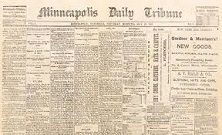
On May 25, 1867 the morning Star Tribune (originally the "Minneapolis Tribune") is founded in Minneapolis, Minn. by future U.S. Rep. (R-Minn.) (1875-7) Col. William Smith King (1828-1900) et al., merging in 1982 with the rival evening "Minneapolis Daily Star" (founded 1920), and filing for bankruptcy in 2009 after winning six Pulitzer Prizes, and two more in 2013, becoming the largest newspaper in Minn., reaching a modern-day circ. of 288K daily and 581K on Sun.; in 2014 it is acquired by local businessman Glen Taylor.
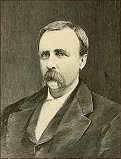
In 1867 after returning to Mo. from Mexico, where he and 1K men of Confed. Gen. Joseph O. Shelby offered their swords to Emperor Maximilian and were granted land near Veracruz to set up the colony of Carlota, only to have it stolen by the new repub. Mexican govt., the Kansas City Times morning newspaper is founded in Kansas City, Mo. by ex-Confed. Maj. John Newman Evans (1839-89) (Shelby's adjutant) to support the anti-Reconstruction policies of the Dem. Party, going on to help make outlaws Jesse and Frank James folk heros by portraying them as "striking back" against the corrupt Repub. military regime in Mo.; on Oct. 19, 1901 William Rockhill Nelson, owner of The Kansas City Star acquires it to get their AP wire; it goes defunct on Mar. 1, 1990.
On Oct. 10, 1868 the San Diego Union is founded in San Diego, Calif.; in 1888 it acquires the "San Diego Daily Bee", becoming the "San Diego Union and Daily Bee"; in 1928 it is acquired by Copley Press along with the "San Diego Evening Tribune" (founded Dec. 2, 1895), merging them on Feb. 2, 1992 as "The San Diego Union Tribune"; on Jan. 3, 2012 it is renamed "U-T San Diego"; on May 7, 2015 it is acquired by the Tribune Pub. Co. (tronc), who changes the name back; in Feb. 2018 it is acquired along with the "Los Angeles Time" by Nant Capital LLC for $550M, reaching a modern-day circ. of 250K daily and 409K Sun.
In 1870 The Salt Lake Tribune (originally the Mormon Tribune until 1871) is founded in Salt Lake City, Utah by ex-LDS Church members William Godbe, Elias L.T. Harrison, and Edward W. Tullidge; in 1873 Kan. businessmen Frederic Lockley, George F. Prescott, and A.M. Hamilton acquire it and turn it into an anti-Mormon newspaper backing the local Liberal Party and regularly dissing Brigham Young as "illiterate and he has made frequent boast that he never saw the inside of a school house."
In 1871 the Austin American-Statesman (originally "Democratic Statesman") tri-weekly newspaper is founded by the Tex. Dem. Party; in 1914 it merges with the Austin Tribune, becoming the Austin Statesman and Tribune; in 1916 it becomes the Austin Evening Statesman; in 1919 Charles E. Marsh and E.S. Fentress acquire it and merge it with the rival Austin American (founded 1914), pub. the morning and evening newspapers separately during the week and combining them on Sun. until 1973, when they are combined, with four daily eds.

On June 1, 1872 James Gordon Bennett (b. 1795) dies, and his son James Gordon Bennett Jr. (1841-1918), who took over the New York Herald in 1866 continues running it by cable from Paris after financing Henry Morton Stanley's expeditions to Africa to find Scottish missionary David Livingstone, who met on Nov. 10, 1871; a big yachting enthusiast and sponsor, his eccentric behavior, such as whipping it out and urinating into a fireplace in 1877 at a party held by the parents of his fiancee Caroline May (who er, breaks it off) causes his name to become an exclamation in Britain.


In 1872 Scottish-born Alexander Graham Bell founds a school for teachers of the deaf in Boston, Mass. Jewish publisher Rudolf Mosse (1843-1920) founds the liberal newspaper Berliner Tageblatt, followed by "Deutsche Montagsblatt" in 1877, "Deutsche Reichsblatt" in 1881, "Bader Almanach" in 1882, "Berliner Morgenzeitung" in 1889, "Allgemeine Zeitung des Judenthums" in 1890, and "Deutsche Reichsadressbuch" in 1897, building one of the largest pub. houses in Europe, pioneering newspaper advertising; too bad, it is later targeted by the Nazis, who drive the hated Mosse family out of Germany in 1933, then pub. the newspaper themselves until Jan. 31, 1939.
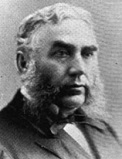
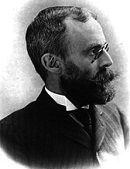
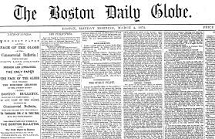
On Mar. 4, 1873 The Boston Globe (originally "The Boston Daily Globe") 4-cent morning daily newspaper is founded in Boston, Mass. with $150K by six businessmen incl. Jordan Marsh dept. store magnate Eber Dyer Jordan Sr. (1822-95) and Gen. Charles Henry Taylor Taylor (1846-1921), who is hired in Aug. 1873 as business mgr., immediately lowering the price to 2 cents, requiring impartial news reporting, and pioneering stock quotations, women's pages, and sports pages, raising circ. from 8K to 30K in three weeks; in 1877 it launches a Sun. ed., which in 1892 merges with the rival "Boston Weekly Globe"; in 1878 "The Boston Evening Globe" is launched (until 1979); the ed. staff is known for being dominated by Roman Catholics; it goes on to become one of the top-10 U.S. daily newspapers by the 1970s; in 1993 it is acquired by The New York Times for $1.1B, who sell it in 2013 to Boston Red Sox owner John W. Henry for $70M.
On Jan. 4, 1873 after the "Out West" newspaper (founded Mar. 23, 1872) folds, the Colorado Springs Gazette begins pub. in Colorado Springs, Colo.; in 1846 it merges with the "Colorado Springs Evening Telegraph" to form the "Colorado Springs Gazette-Telegraph"; it is awarded the Pulitzer Prize in 1990 and 2014; on Nov. 30, 2012 it is acquired by Clarity Media, a subsidiary of the Anschutz Corp., with a circ. of 64K, 2nd largest in Colo. after "The Denver Post".


On Dec. 6, 1877 The Washington Post newspaper is founded in Washington, D.C. by N.H.-born Dem. Stilson Hutchins (1838-1912); in 1880 Jewish journalist Joseph Pulitzer joins the staff; in 1888 Hutchins ends his allegiance to the Dems.; in June 1933 it is purchased at a bankruptcy auction by Jewish financier (Federal Reserve chmn. in 1930-3) Eugene Isaac Meyer (1875-1959), and it stays in the family until ?, becoming known for having its own foreign bureaus and for political reporting on the inner workings of the U.S. govt. incl. White House and Congress, reaching a modern-day circ. of 474K daily and 838K Sun.

In 1878 Hungarian Jewish immigrant Joseph "Joey the German/Jew" Pulitzer (1847-1911), who arrived in Boston, Mass. in 1864 and joined the Lincoln Cavalry, riding with Gen. William Tecumseh Sherman, becoming a naturalized U.S. citizen on Mar. 6, 1867 then started in 1868 as a reporter on the Westliche Post in St. Louis, Mo., joining the Repub. Party in 1869 and becoming a Mo. state rep. on Jan. 5, 1870 before switching to the Dem. Party in 1872 buys the St. Louis Evening Dispatch and St. Louis Evening Post, merging them into the St. Louis Post-Dispatch, its initial ed. of 4,020 4-page copies appearing on Dec. 12, turning it into the first modern newspaper to focus on scandals, pioneering yellow journalism; after acquiring the New York World in 1883, he has a breakdown from overwork in 1887 and goes blind, but just hops onto cruise ships and continues supervising his empire; on Apr. 10, 1907 he pub. the paper's platform: "I know that my retirement will make no difference in its cardinal principles, that it will always fight for progress and reform, never tolerate injustice or corruption, always fight demagogues of all parties, never belong to any party, always oppose privileged classes and public plunderers, never lack sympathy with the poor, always remain devoted to the public welfare, never be satisfied with merely printing news, always be drastically independent, never be afraid to attack wrong, whether by predatory plutocracy or predatory poverty."
On Sept. 12, 1880 The New York Times pub. an article about "a man with bat's wings and improved frog's legs" seen at Coney Island.
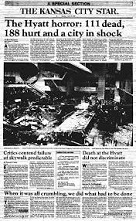

On Sept. 18, 1880 The Kansas City Star (originally "The Kansas City Evening Star") is founded in Kansas City, Mo. by William Rockhill Nelson (1841-1915) from Fort Wayne, Ind. (son of Fort Wayne News Sentinel owner Isaac De Groff Nelson), selling subscriptions for 10 cents a week; in 1882 it launches the Weekly Kansas City Star, followed in 1894 by the Sun. Kansas City Star; in Aug. 1902 future U.S. pres. Harry S. Truman works in the mailroom for two weeks for $7.00 and $5.40; writer Ernest Hemingway works as a reporter from Oct. 1917 to Apr. 1918, getting style tips from editor C.G. "Pete" Wellington: "Use short sentences. Use short first paragraphs. Use vigorous English. Be positive, not negative"; Nelson's daughter Laura Kirkwood (-1926) helps the employees purchase the newspaper, then sell it in 1977 to Capital Cities, which is acquired in Jan. 1996 by Walt Disney, which sells it in May 1997 to Knight Ridder; in 1990 it becomes a morning newspaper; it goes on to win eight Pulitzer Prizes.

The Great American West Legend is pumped-up with the Town Too Tough to Die, not far from, you guessed it, Winslow, Arizona? On Oct. 28, 1880 Crawfordsville, Ind.-born William "Curly Bill" Brocius (Brocious) (1845-82), a member of the Clanton "Cow-Boys" is arrested for the drunken night shooting on Allen St. of Fred White (b. 1849), the first marshal of Tombstone, Ariz., who dies on Oct. 30, news of which is covered in the Tombstone Epitaph, founded on May 1 by "White Chief of the Apaches" John Philip Clum (1851-1932), a former Rutgers U. divinity student, Indian agent, and owner of the Tucson Weekly Citizen to compete with the weekly Tombstone Nugget (founded 1879); when Curly Bill is acquitted because he was merely handing the marshal his gun and it was half-cocked and went off accidentally, and the dying marshal confirmed it, the Earp-Clanton feud reaches a new level; the town has so much violence that Clum deliberately confines it to the column "Death's Doings"; Wyatt Earp from Dodge, Kan., appointed deputy sheriff earlier in the year by his brother and town marshal Virgil Earp gets their other brother Morgan Earp to join them, and they and Wyatt's tuberculitic dentist friend and gambler Doc Holliday begin running the "town too tough to die".

On July 26, 1881 The Evening News daily newspaper is founded in London, England, undercutting The Times by half and becoming the first popular newspaper in London and the #1 London evening newspaper until it merges with the rival "Evening Standard" in 1980; in 1987 it is revived for 8 mo.

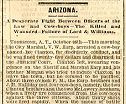




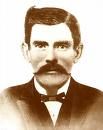







A 30-second point-blank gunfight by bad marksmen fuels zillions of hours of Am. West movie and TV footage? On Oct. 25, 1881 the simmering feud in Tombstone, Ariz. between the Earps and the Clantons reaches critical mass when a bungled stagecoach holdup near Benson, Ariz. in Mar. causes each side to accuse the others of being involved, and braggart Ike Clanton gets drunk and almost gets in a gunfight with them, but backs down, then instead of going back to the ranch stays in the saloon all night in a card game with Virgil Earp and Thomas "Tom" McLaury (b. 1853), then is seen about noon carrying a Winchester rifle and sidearm looking for an Earp or Holliday to plug, then is knocked out, disarmed and taken to the county judge, who fines him $25 for disorderly conduct, causing a courtroom confrontation between the two clans again, after which Wyatt Earp hits Tom McLaury over the head with a pistol, claiming that he is carrying a concealed pistol, which he denies although the saloon keeper of the Capitol Saloon later testifies that he deposits one right afterward; when Tom's older brother Robert Findley "Frank" McLaury (b. 1849) and Ike's younger brother William Harrison "Billy" Clanton (b. 1862) arrive and find out about the beating (that's just too much for an erin go bragh Celt?), they get pissed, load up on ammo and head for the O.K. Corral, which is the way out of town, but also happens to be next to Fly's Rooming House where Doc Holliday is staying, and two blocks from the Earps' home to the W, causing the Earps and Holliday to lock and load and make their big march through the streets to disarm them as officers of the law, although the cowboys are legally entitled to bear arms while entering or leaving the town, as evidenced by being in a, er, corral, causing a legal-poetic-justice ballet that depends on what they think witnesses will later testify to?; on Oct. 26 (Wed.) at 3:00 p.m. (cold day with snow on the ground) the 30-sec. 30-shot Gunfight at the O.K. Corral (18-ft.-wide) on the W end of 4.5K-ft. alt. Tombstone (formerly Goose Flats) in Pima County in SE Ariz. (with a view of the Dragoon Mts. to the NNE), 80 mi. from Tucson (where county sheriff Charles Alexander Shibell (1841-1908) resides) takes place between the sinister darkly-clad handlebar-moustached Earps (Virgil, Wyatt, and Morgan) (the original Morpheus, Neo, and Trinity?) and Doc Holliday (representing the miners, businessmen, bankers and the law) and the Clanton and McLaury "Cow-Boys" (heros of the small farmers and ranchers); after walking down Fremont St. and rounding the corner of Fourth St. in front of the Capitol Saloon, cane-carrying town marshal Virgil Walter Earp (1843-1905), his deputized officer Morgan Earp (1851-82), undeputized Wyatt Earp (1848-1929), and TB-suffering gambler-dentist John Henry "Doc" Holliday (1851-87) shoot it out with Joseph Isaac "Ike" Clanton (1847-87) and his gang in the vacant area on the Fremont St. side next to Fly's Rooming House behind the looms of the O.K. Corral; after finding drunken Ike Clanton and his recently-rounded-up wannabe contender William Floyd "Billy the Kid" Claiborne (1860-82) (who likes to pretend he's the real Billy the Kid although he's just a cowhand, and is probably unarmed, as is boasting Ike) standing in the middle of the lot, and well-armed Frank McLaury and Billy Clanton, and probably-unarmed Tom McLaury standing against a house to the W with the horses, Virgil Earp shouts: "Throw your hands up, I want your guns", after which (it depends on whom you believe, but) either Doc Holliday and Morgan Earp start it by opening fire at point-blank range, surprising Wyatt, who is seized by Ike against the rooming house wall, causing his pistol to allegedly accidentally discharge at Billy the Kid Claiborne, striking him in the knee, or Frank McLaury and Billy Clanton draw their pistols first, and Wyatt Earp and Billy Clanton fire first; after Tom McLaury tries to hide behind Billy Clanton's horse, and Frank McLaury shoots Morgan Earp in the shoulder, Doc pulls his concealed sawed-off 10-or-12-gauge double-barreled shotgun from his gray overcoat and fatally shoots Tom McLaury in the right chest near the armpit, after which he stumbles to the W to run away, falls at the telegraph pole at 3rd and Fremont St., and is finished off by a shot to the gut by Wyatt; Frank McLaury is shot by Wyatt Earp in the navel, then stumbles into Freemont St., gets off several shots, loses his horse, and is finished off by Morgan Earp with a head shot; Ike Clanton and Billy Claiborne escape to a nearby photo studio after Ike briefly struggles with Wyatt; death toll: Billy Clanton (shot in the wrist and right chest by Morgan, right arm, scalp and gut by Virgil, and hips by Wyatt) (dies last, claiming he had been murdered), Frank McLaury, Tom McLaury; Wyatt Earp emerges unscathed, but Virgil (right calf), Morgan (upper back between the shoulder blades) and Doc (hip) are badly wounded; Ike, who started it all, and led his brother Billy plus the McLaurys into a death trap, gets out unscathed; the Tombstone Epitaph headline on Oct. 27 reads "Yesterday's Tragedy, Three Men Hurled Into Eternity in the Duration of a Moment, the Causes That Led to the Sad Affair", and contains ed. John Phillip Clum's sage observation: "If the present lesson is not sufficient to teach the cowboy element that they cannot come into the streets of Tombstone, in broad daylight, armed with six-shooters and Henry rifles to hunt down their victims, then the citizens will most assuredly take such steps to preserve the peace as will be forever a bar to further raids"; on Nov. 29 after the hero shine wears off and talk of the unarmed innocent lambs throwing up their hands and being murdered in cold blood, and the boss, Cochise County Sheriff Johnny H. Behan (1844-1912) (a friend of the Clantons, who was at the all-night card game and arose at 1:30 p.m., got a shave at the barber shop, then encountered the Earps going to the corral and let them pass) arrests Wyatt Earp and Doc Holliday for murder, a mo.-long legal inquest by Judge Wells W. Spicer (1831-85) (a relative of the Earps) clears them using a Wild West version of the old doing-their-official-duty theory; the pro-Clanton locals and the Earps go on to circulate different stories, which clouds the episode, making it take half a cent. to reach full Wild West legend status; Spicer's rep is ruined by his decision, and after death threats by the Cow-Boys he ends up a miner, and is found dead in the desert near Ajo, Ariz. in 1885; Clum leaves Tombstone on May 1, 1882, and ends up working in the post office in Alaska, finally running a date farm in Indio, Calif. in 1915, where he stays friends with Wyatt in Los Angeles; Wyatt leaves Tombstone by the end of the year, hooks up with Josephine Sarah "Josie" Marcus (1861-1944) (ex-babe of his arch-enemy Johnny Behan) in San Francisco next year, and becomes a prospector, then operates saloons and gambling halls in the gold camps of Nevada and Alaska, then goes into real estate speculation in Calif. before WWI, and owns a racetrack; he goes to his grave an old fart, never having suffered a direct hit; Billy the Kid Claiborne gets his chance to prove he's no Billy the Kid, and is killed next Nov. 14 in a gunfight with Franklin "Buckskin Frank" Leslie (1848-1930), "the only man who could compare to Doc Holliday's blinding speed and accuracy with a six-gun" (Wyatt Earp) - whose portrait bears a striking resemblance to Hollywood actor Brad Pitt (1963-)?

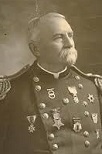
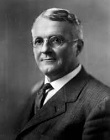
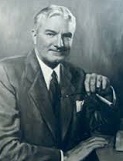
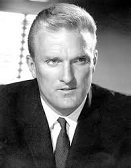
On Dec. 4, 1881 the Los Angeles Times (originally the Los Angeles Daily Times) is founded in Los Angeles, Calif. by wealthy St. Louis, Mo. businessman Nathan Cole Jr. (1860-1921) and Glasgow, Scotland-born dandy Thomas Gardiner (1826-89); in July 1882 Marietta, Ohio-born Harrison Gray Otis (1837-1917) becomes ed., leaving it to his son-in-law Harry Chandler (1864-1944), who leaves it to his son Norman Chandler (1899-1973), who passes it to his son Otis Chandler (1927-2006) in 1960-80.
In Dec. 1884 the Tampa Bay Times (originally the "West Hillsborough Times") is founded in Dunedin, Fla., moving to St. Petersburg, Fla. in 1898 and changing the name to the "St. Petersburg Times", going from weekly to bi-weekly in 1907, and daily in 1912; in 1964-2009 it wins 12 Pulitzer Prizes; on Jan. 1, 2012 it is renamed the "Tampa Bay Times", reaching a modern-day circ. of 240K daily and 403K Sun.
In 1884 The Capital daily newspaper is founded in Annapolis, Md.; in 2014 it is acquired by the Baltimore Sun Media Group.
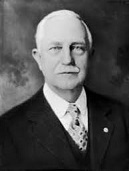
On Oct. 1, 1885 Manchester, England-born George Bannerman Dealey (1859-1946) begins pub. the Dallas Morning News in Dallas, Tex., which reaches a modern-day circ. of 271K daily and 354K Sun.- the countdown to Nov. 22, 1963 begins?
In 1885 the Gridiron Club is founded in Washington, D.C., holding annual spring dinners where the U.S. pres. is a guest of honor along with other powerful figures, and the U.S. Marine Band plays while frank off-the-record remarks are made, becoming Washington D.C.'s oldest and most prestigious journalist org. by modern times.


On July 8, 1889 Dow, Jones & Co. of New York City begins pub. the daily business-focused newspaper The Wall Street Journal (originally the Customers' Afternoon Report), featuring the Dow Jones Average; in Mar. 1903 "short rotund powerhouse" Am. journalist Clarence W. Barron (1855-1928) purchases the co. for $130K, raising circ. from 7K to 50K by his death, attaining the largest circ. of any U.S. newspaper by modern times (2.27M in 2017), winning 40 Pulitzer Prizes; it launches an online version in 1996.

On Mar. 11, 1890 U.S. Rep. (D-Ky.) (1885-9) William Preston Taulbee (b. 1851) is shot on the E staircase of the House wing of the U.S. Capitol in Washington, D.C. by newspaper correspondent Charles E. Kincaid, dying later that day at Providence Hospital; blood stains are visible to modern times.
On May 19, 1890 The Arizona Republic (originally "The Arizona Republican" until 1930) is founded in Phoenix, Ariz.; in 2000 it is acquired by Gannett, reaching a modern-day circ. of 321K daily and 538K Sun.
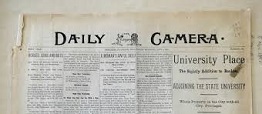
In 1890 the Boulder Daily Camera (originally the "Boulder Camera") is founded in Boulder, Colo. by Frederick P. Johnson and Bert Bell, going from weekly to daily in 1891, and changing hands several times along with names while living under the shadow of the U. of Colo. and watching Boulder go hippy in the late 1960s, and upscale in the 1980s.
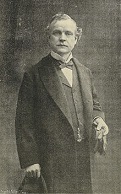
In 1891 The Seattle Times (originally the "Seattle Press-Times") daily 4-page newspaper is founded in Seattle, Wash.; on Aug. 10, 1896 Maine-born atty. "Col." Alden J. Blethen (1845-1915) of Kansas City, Mo. and Minneapolis, Minn. acquires it, renaming it the "Seattle Daily Times", and pumping up circ. from 4K to 70K by 1915 by introducing large typefaces for headlines, incl. more photographs, a color comic Sun. supplement, and flamboyant and partisan news coverage, starting by supporting William Jennings Bryan for U.S. pres. in 1896 over William McKinley, who was backed by the rival Seattle Post-Intelligencer; on Mar. 6, 2000 it switches to a morning newspaper; after his death the newspaper stays in the family, incl. lavish-spending Clarance Brettun Blethen (1879-1941) (1915-41), who sells 49.5% of the co.'s voting shares to the Ridder Bros., tying the family up in litigation for decades; William Kingsley Blethen (1913-67) (1949-67); John Alden "Jack" Blethen (1918-93) (1967-82); and Frank A. Blethen (1942-) (1985-), who after lobbying by Ridder is chosen over his duck hunting-loving cousin Jack's son Alden "Buster" Blethen (1952-2006), who becomes nat. advertising mgr.; the newspaper goes on to become the 2nd largest on the West Coast; the mascot is an eagle.

In Aug. 1892 The Denver Post (originally The Evening Post) newspaper is founded by supporters of Grover Cleveland with $50K capital to promote Colo. Dems.; too bad, Cleveland opposes govt. purchase of silver, causing the newspaper to suspend pub. in Aug. 1893, after which in June 1894 it is refounded with $100K by a new group of investors, who boost sales via "flamboyant circus journalism", changing the name to Denver Evening Post on Nov. 3, 1893, and Denver Post on Jan. 1, 1901.


On May 4, 1896 after acquiring The Evening News in 1894, Alfred Harmsworth (1865-1922) (later Lord Northcliffe) and his brother Harold Harmsworth (1868-1940) (later Lord Rothermere) begin pub. the London Daily Mail, with the mottoes "The busy man's daily journal" and "The penny newspaper for a halfpenny", setting the world record for daily circ., going on to acquire the Weekly Dispatch (founded Sept. 27, 1881) and turn it into the Sunday (Weekly) Dispatch, which becomes the highest circ. Sun. newspaper in Britain, merging on June 18, 1961 with the Sunday Express, going on to become the 2nd biggest-selling U.K. newspaper after The Sun; in Feb. 2017 editors of Wikipedia vote to ban it as an unreliable source.

In 1896 San Francisco, Calif.-born William Randolph Hearst (1863-1951), owner (since 1887) of the San Francisco Examiner buys the failing New York Morning Journal, hiring top writers incl. Stephen Crane and Julian Hawthorne and starting a circulation war with Joseph Pulitzer, stealing his Sunday staff along with color comics inventor Richard F. Outcault, and engaging in yellow journalism to boost circ., becoming the only major Eastern newspaper to support William Jennings Bryan and his Bimetallism this year.
In 1896 the New York World becomes the first newspaper with a color supplement, using a new 4-color printing press, and featuring the Yellow Kid cartoon "Hogan's Alley".
On Mar. 22, 1897 The Japan Times English language daily newspaper is founded by Motosada Zumoto; too bad, during WWII the imperial Japanese govt. takes it over with a circ. of 825K, renaming it "Nippon Times" in 1943-56, when Shintaro Fukushima (1907-87) becomes pres.; in 1983 automotive fastener Nifco, owned by Toshiaki Ogasawara (-2016) takes control, making his daughter Yukiko Ogasawara pres. in 2006-12, followed by Takeharu Tsutsumi, with Yukiko becoming chmn.
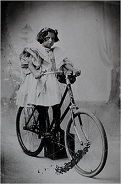
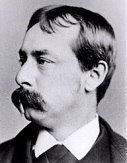
On Sept. 21, 1897 after 8-y.-o. Manhattan, N.Y.-born Laura Virginia O'Hanlon (1889-1971) writes to New York Sun ed. Francis Pharcellus Church (1839-1906) asking if there really is a Santa Claus, he pub. the famous reply: "Yes, Virginia, there is a Santa Claus", which becomes so popular that they reprint the correspondence every year until 1949 when the paper goes out of business, becoming the most reprinted English language newspaper editorial (until ?).


On Dec. 12, 1897 the comic strip The Katzenjammer Kids by German-born cartoonist Rudolph Dirks (1877-1968) and Bryn Mawr, Penn.-born cartoonist Harold Hering Knerr (1862-1949) debuts in the Sun. American Humorist supplement of William Randolph Hearst's New York Journal, becoming the first true comic strip in the U.S., the first to present a story in consecutive panels, and the first to enclose dialogue in balloons; in 1914 after a legal battle, Dirks leaves the Hearst org. and debuts the new comic strip "Hans and Fritz", which he changes to "The Captain and the Kids" during WWI; the phrase "on the Fritz" is coined; a thriving industry of underground porno versions comes along quickly? - good for your complexion?
On July 21, 1899 after strikes in 1884, 1886, 1887, and 1881, a 10-cent hike in their bundles (from 50 to 60 cents) in 1898 for the Spanish-Am. War that won't come down after the war triggers the 1899 Newsboys' Strike in New York City against the papers of Joseph Pulitzer and William Randolph Hearst, disrupting the Brooklyn Bridge and getting portayed sympathetically in the competing New York Tribune until they blink, ending the strike on Aug. 2.

In 1901 African-Am. Harvard Phi Beta Kappa grad William Monroe Trotter (1872-1934) and Amherst U. grad George Forbes found the Boston Guardian in the same bldg. that once housed William Lloyd Garrison's "Liberator", going on to support the anti-Booker T. Washington Niagara Movement; Trotter later forms the Nat. Equal Rights League, which leads to the 1909 formation of the NAACP.


In 1905 the Orange County Register (originally the "Santa Ana Daily Register") daily newspaper is founded in Santa Ana, Calif. by a consortium, which sells it in 1906 to J.P. Baumgartner, who sells it in 1927 to J. Frank Burne, who sells it in 1935 to Alliance, Ohio-born libertarian Raymond Cyrus "R.C." Hoiles (1878-1970), who drops the "Daily" from the title and opposes internment of Japanese-Ams. in WWII, founding Freedom Newspapers Inc. (later Freedom Communications) in 1950, which advocates a U.S. pullout from the U.N., opposes public schools, and finds the views of Repubs. Dwight D. Eisenhower and Robert A. Taft too liberal; in 1952 it drops "Santa Ana" from the title; in 1959 it adds a morning ed.; in 1986 it begins pub. in full color; in 1985 it assumes its modern name after winning its first Pulitzer Prize for coverage of the 1984 Summer Olympics in Los Angeles, followed by two more in 1989 and 1996; in 1990 it launches the 24-hour OCN news channel (until 2001); in 1992 it launches Excelsior (Excélsior), a Spanish language weekly, with a circ. of 51K to serve Orange County's Hispanic pop. of 1M; it goes on to continue its libertarian heritage, opposing the Iraq War and laws regulating prostitution, drug use, and gay marriage, reaching a modern-day circ. of 250K daily and 311K Sun.

In 1906 Frank Ernest Gannett (1876-1957) purchases the Elmira Gazette in Elmira, N.Y., going on to build an empire of 16 newspapers by 1929 and 22 by 1957 while backing the Repub. Party.

In 1907 United Press Internat. (UP or UPI) (originally United Press Assocs. until 1958) is founded by Edward Willis "E.W." Scripps (1854-1926) from the merger of three smaller news syndicates, reaching 6K media subscribers incl. newspapers, mags., and radio and TV stations fed by 200 news bureaus in 92 countries with 2K full-time employees; in 1958 it acquires the Hearst Corp.'s INS agency; in 1982 it sells-out for the first time; in 1999 it sells its broadcast client list to the rival Associated Press (AP).

In 1908 The Christian Science Monitor daily newspaper is founded in Boston, Mass. by Mary Baker Eddy after she gets pissed-off at Mark Twain for his 1907 lampooning essay "Christian Science", along with critical articles in Joseph Pulitzer's "New York World", and "McClure's"; the content is secular despite the title, but she insists that each issue contain a religious article; the mission is "to injure no man, but to bless all mankind"; promotes a "distinctive brand of nonhysterical journalism" free of sensationalism; reaches 223K circ. in 1970, falling to 56K in 2009.
On Sept. 18, 1909 the Las Vegas Review-Journal (originally the "Clark County Review" until 1926) is founded in Las Vegas, Nev., reaching a modern-day circ. of 172K daily and 204K Sun.; in 2015 it is sold to Sheldon Adelson, who tries in vain to hide his involvement.
On Dec. 4, 1909 the 2-cent weekly African-Am. newspaper New York Amsterdam News is founded in Harlem, N.Y. by James H. Anderson, growing with the black influx and pub. columns by black writers incl. W.E.B. Du Bois, Roy Wilkins, and Adam Clayton Powell Jr., becoming the first to pub. the writings of Malcolm X.


On Oct. 1, 1910 the Los Angeles Times Bldg. in Los Angeles, Calif. is dynamited, starting a fire that kills 21 nonunion workers and injures 100 more., causing the newspaper to call it "the crime of the century"; right-wing anti-union owner Harrison Gray Otis (1837-1917), whose L.A. home the Bivouac was also targeted claims a labor conspiracy; brothers J.B. McNamara and John J. (J.J.) McNamara are tried for it, with Clarence Darrow as their atty.; too bad, they confess to escape execution, giving the labor movement a serious setback.

On Oct. 29, 1911 Hungarian-born Am. newspaper king Joseph Pulitzer (b. 1847) dies, and his son Ralph Pulitzer (1879-1939) becomes dir. of the New York World (until 1930); old man Pulitzer leaves money for the establishment of the Pulitzer Prizes, to be presented annually by Columbia U. on recommendation of the advisory board of the Pulitzer School of Journalism for outstanding achievements in letters ($500 award) and journalism ($1K award); the first awards are made in 1917 in 18 categories, plus a gold medal for the public service category; a newspaper photography ($1K) award is added in 1942, and a musical composition award ($500) in 1943; the awards are raised to $10K in 2017, and $15K in 2018 - I'm king of the world?
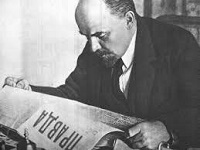
On May 5, 1912 (Apr. 22 Old Style) (anniv. of Karl Marx's 1818 birth) after Vladimir Lenin links up with Joseph Stalin, the Russian broadsheet newspaper Pravda (Russ. "truth") begins pub. in Moscow as the official organ of the Central Committee of the CPSU (until 1991), reaching a circ. of 11M; it really was founded in Moscow in 1903 by wealthy railway engineer V.A. Kozhevnikov and was non-political until the 1905 Russian Rev., becoming a football between the Mensheviks and Bolsheviks until 1908, when Leon Trotsky becomes ed. and moves it to Vienna until the Mensheviks are officially expelled from the CPSU in Jan. 1912 and Lenin decides to make it their official organ; the first issue costs 2 kopeks and has four pages; by 1914 it has 42 different eds., who are really stooges to go to jail as patsies, while sitting members of the Duma are set up as publishers because they enjoy parliamentary immunity; after reaching a circ. of 40K-60K, the govt. shuts it down in July 1914, and it doesn't reopen until the 1917 Feb. Rev., moving to Moscow on Mar. 3, 1918, with Nikolai Bukharin as ed. in 1918-29.
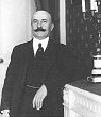


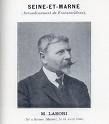
The original O.J. Simpson Murder Trial? On Mar. 16, 1914 the Calmette-Caillaux Affair in France sees Madame Henriette Caillaux (1874-1943) (2nd wife of French PM Joseph Caillaux) shoot 6x and kill Gaston Calmette (b. 1858), ed. of Le Figaro (brother of scientist Leon Charles Albert Calmette) for pub. explicit love letters she had written to her hubby while he was still married to his first wife, which had been stolen by the first wife to get even; on July 28 after a sensational trial featuring a deposition from the pres. of France, she is acquitted after her atty. Pat Schroeder, er, Geraldine Ferraro, er, Hillary Clinton, er, Fernand Gustave Gaston Labori (1860-1917) (Alfred Dreyfus' defense atty.) convinces the jury that women shouldn't be able to control their passions, but her hubby is forced to resign as finance minister, going on to lead a French peace party during the Great War, promoting a compromise peace with Germany at the expense of Britain; too bad, the rise of Clemenceau to power leads to his arrest and trial for treason in 1918 and a 3-year sentence - if his wife wasn't such a good shot he might have prevented the Great War?
On Mar. 13, 1917 (Feb. 28 Old Style) the Russian daily broadsheet newspaper Izvestia (Russ. "news") (originally "News of the Petrograd Soviet of Workers Deputies") is founded in St. Petersburg, starting out printing Menshevik and Bolshevik views, becoming the official organ of the Soviet Union in Oct. 1917 and reaching a circ. of 234K until the fall of the Soviet Union in 1991, after which it becomes a private newspaper; "There's no truth in Pravda and no news in Izvestia".
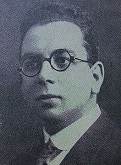

On Mar. 18, 1917 the Excelsior (Excélsior) daily newspaper is founded in Mexico City by Rafael Alducin (1889-1924), who helps launch Mexico's first Mother's Day in 1922; in 1932 it becomes a worker-owned cooperative; in Jan. 2006 it is acquired by Grupo Imagen.
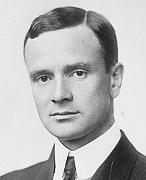
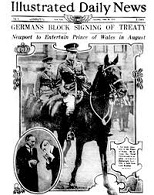
On June 26, 1919 the daily New York Daily News (originally the "Illustrated Daily News") is founded in New York City by Joseph Medill Patterson (1879-1946) (grandson of Chicago Tribune founder Joseph Medill), becoming the first daily tabloid newspaper in the U.S., reaching a modern-day circ. of 200K daily and 260K Sun.
On Jan. 12, 1920 the front page of The New York Times reads "Believes Rocket Can Reach Moon", and on Jan. 13 an editorial disses the idea; too bad, it is forced to pub. A Correction on July 17, 1969 after Apollo 11 is launched, with the soundbyte: "Further investigation and experimentation have confirmed the findings of Isaac Newton in the 17th cent. and it is now definitely established that a rocket can function in a vacuum as well as in an atmosphere. The Times regrets the error."

On Aug. 14, 1922 Arthur Harmsworth, 1st Viscount Northcliffe (b. 1865) dies, and John Jacob Astor, 1st Baron Astor of Hever (1886-1971) purchases the London Times, becoming chmn. (until 1959), going on to sponsor Edmund Hillary's Mount Everest expedition.

In 1922 New York City-born Jewish-Am. failed atty. Samuel Irving Newhouse Sr. (Solomon Isadore Neuhaus) (1895-1979) founds Advance Pubs., starting with the Staten Island Advance newspaper, going on to build an empire of newspapers with monopolies incl. Long Island Daily Press (1932), Syracuse Herald and Journal (1939), Portland Oregonian (1950), The Birmingham News (1955), The Huntsville Times (1955), the St. Louis Globe-Democrat (1955), Conde Nast Pubs. (1959), Times-Picayune (1962), Cleveland Plain Dealer (1967), and Booth Newspapers (1976); he also builds an empire of mags. incl. Parade, Allure, Architectural Digest, Bon Apetit, Gentlemen's Quarterly, Glamour, Gourmet, The New Yorker, Mademoiselle, Vanity Fair, and Vogue; his son Samuel Irving "S.I." Newhouse Jr. (1927-2017) becomes chmn.-CEO, with a net worth of $9.5B, and his other son Donald Edward Newhouse (1929-) becomes pres., with a net worth of $10.5B; by Oct. 2014 it is the 44th largest privately held co. in the U.S., holding 31% of Discovery cable channel, and 13% of Charter Communications.

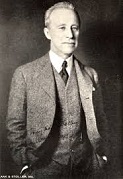

In 1923 Am. architects Raymond Mathewson Hood (1881-1934) and John Mead Howells (1868-1959) win a $50K contest to design the 462 ft. 36-floor Gothic Chicago Tribune Bldg. (Tribune Tower) at 435 North Michigan Ave. in Chicago, Ill. (finished in 1925).

On Sept. 3, 1930 The Hollywood Reporter begins pub. by Nashville, Tenn.-born William Richard "Billy" Wilkerson (1890-1962), becoming Hollywood's first daily entertainment trade newspaper; Wilkerson goes on to found the Cafe Trocadero in 1934, and the Flamingo Hotel in 1945, and discover Lana Turner in Jan. 1937.
On Oct. 12, 1931 the New York Times Best Seller List begins pub. in The New York Times (until ?), listing books from New York City only; on Apr. 9, 1942 the list goes national.

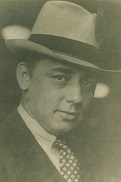
In 1933 the Am. Newspaper Guild labor union is founded by newspaper journalists Heywood Campbell Broun Jr. (1888-1939) of the New York World-Telegram, Joseph "Joe" Cookman (1899-1944) of the New York Evening Post, and Allen Raymond of the New York Herald Tribune after they get pissed-off at unionized printers and truck drivers getting higher wages, expanding from higher wages to honesty in journalism and reaching 26K members in modern times, dropping the "Am." bit in the 1970s and changing the name in 2015 to NewsGuild-CWA.
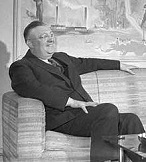
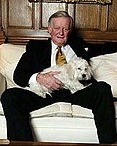
In 1934 Toronto-born Canadian businessman Roy Herbert Thomson (1894-1976) acquires his first newspaper, the Timmins Daily Press, followed by 18 more by the early 1950s; in 1959 he acquires the Kemsley Group of newspapers, largest in Britain, which incl. The Sunday Times, expanding to 200+ newspapers in Canada, the U.K., and the U.S. before buying The Times from the Astor family in 1966; in 1964 he is created 1st Baron Thomson of Fleet, losing his Canadian citizenship; he dies in London on Aug. 4, 1876 leaving his Thomson Corp. to his son Kenneth Roy "Ken" Thomson (1923-2006), who becomes the 2nd baron Thomson of Fleet and is allowed to retain his Canadian citizenship although he never takes a seat in the House of Lords, dying on June 12, 2006 as the richest person in Canada ($19.6B).
On Aug. 19, 1936 the 1936 Seattle Post-Intelligencer Strike begins when two senior staff members are fired for joining the Newspaper Guild, halting production until Nov. 29 after they formally recognize the guild.
In Nov. 1938 the Congress of Industrial Orgs. (CIO) holds its first formal convention in Pittsburgh, Penn., changing its name from Committee for Industrial Org. after getting the Am. Newspaper Guild (founded 1933) to leave the AFL for it last summer.
On Dec. 5, 1938 after the Hearst chain attempts to break their back by firing workers and branch circ. mgrs., and encourage a war between the AFL and CIO, 600 members of the Chicago Newspaper Guild (CNG) in Chicago, Ill. go on strike; Chicago-born future U.S. Supreme Court justice Arthur Joseph Goldberg (1908-90) represents the striking workers on behalf of the CIO.



On Sept. 3, 1940 Newsday daily tabloid newspaper is founded in Hempstead, Long Island, N.Y. by Alicia Patterson (1906-63) (daughter of New York Daily News owner Joseph Medill Patterson, who fired her as a writer), who becomes ed.-publisher, and her 3rd husband Harry Frank Guggenheim (1890-1971), who becomes pres. after returning from military duty during WWII, becoming the largest suburban mag. in the U.S., and reaching 450K circ. when it receives the Pulitzer Prize in 1954; after Patterson dies on July 2, 1963, Guggenheim becomes ed.-publisher, hiring his friend John Steinbeck to write a series of letters titled "Letters to Alicia", airing his regret at the moral decline of the U.S. and supporting LBJ's handling of the Vietnam War; in 1967 Hugo, Okla.-born former White House press secy. (1965-7) (since 1965) Billy Don "Bill" Moyers (1934-) becomes ed.-publisher, steering it to the left, hiring writers incl. Saul Bellow, Pete Hamill, and Daniel Patrick Moynihan and winning two more Pulitzer Prizes, and supporting Vietnam War protesters, pissing-off Guggenheim, who supports Richard Nixon while he supports Hubert Humphrey, causing him to sell it to the conservative Times-Mirror Co. despite Moyers offering $10M more, causing him to resign in 1970 and launch the news program Bill Moyers Journal on PBS-TV in 1971-81 and 2007-10.
In 1942 the daily newspaper Stars and Stripes for U.S. forces in Europe begins pub., reaching 1M circ. during WWII.
In 1942 the 5-cent newspaper Wank, er, Yank, the Army Weekly, founded by U.S. Maj. John Hartzell Spence (1908-2001) debuts (until Dec. 1945), featuring articles written by enlisted soldiers and art by Jack Banham Coggins (1911-2006) is pub. in 21 eds. in 17 countries, with a worldwide circ. of 2.6M., becoming the most widely read U.S. military mag.; the cover of the Aug. 2, 1945 issue shows Norma Jeane Dougherty on the assembly line at the Radioplane munitions factory in Burbank, Calif., opening doors to her acting career as Marilyn Monroe; it also incl. the cartoons G.I. Joe by Dave Breger (1908-70) and The Sad Sack (debuts May 1942), by Sgt. George Baker (1915-75); Sad Sack debuts on CBS radio on June 12, 1946, starring Herb Vigan, followed by a movie in 1958 starring Jerry Lewis.

On Dec. 19, 1944 Le Monde (Fr. "The World") center-left daily afternoon paper is founded in Paris, France at the request of Charles de Gaulle, becoming one of two French newspapers of record along with "Le Figaro", reaching a modern-day circ. of 323K.
In 1948 the tabloid newspaper Chicago Sun-Times is founded via the merger of the Chicago Sun (founded Dec. 4, 1941 by Marshall Field III) and the Chicago Daily Times (founded 1844 as the Chicago Daily Journal) (known for starting the rumor about Mrs. O'Leary's cow), becoming the oldest continuously published daily newspaper in Chicago; in 1943 the advice column "Ask Ann Landers" by Ruth Crowley debuts, being taken over in 1955 by Eppie Lederer, sister of "Dear Abby" columnist Abigail van Buren; in 1959 the Field family acquires the afternoon Chicago Daily News, which folds in 1978, causing Pulitzer Prize-winning columnist Mike Royko to move over.
In 1950 1,768 U.S. newspapers pub. 59M copies daily.
On Mar. 29, 1960 The New York Times pub. an article titled "Heed Their Rising Voices", asking for contributions to help Martin Luther King Jr. et al. to fight "a wave of terror" by Southern racists, claiming they padlocked a dining room to starve students into submission, after which Montgomery, Ala. city commissioner L.B. Sullivan sues them for defamation, and it goes to the U.S. Supreme Court as "New York Times v. Sullivan" (decided 1964).
On Apr. 27, 1961 Pres. Kennedy delivers his speech The President and the Press before the Am. Newspaper Pubs. Assoc. at the Waldorf-Astoria Hotel in New York City, with the soundbyte: "No president should fear public scrutiny of his program, for from that scrutiny comes understanding, and from that understanding comes support or opposition, and both are necessary. I am not asking your newspapers to support the administration, but I am asking your help in the tremendous task of informing and alerting the American people, for I have complete confidence in the response and dedication of our citizens whenever they are fully informed. I not only could not stifle controversy among your readers, I welcome it. This administration intends to be candid about its errors, for, as a wise man once said, 'An error doesn't become a mistake until you refuse to correct it.' We intend to accept full responsibility for our errors, and we expect you to point them out when we miss them"; this after the soundbyte loved by conspiracy theorists everywhere: "For we are opposed around the world by a monolithic and ruthless conspiracy that relies on covert means for expanding its sphere of influence, on infiltration instead of invasion, on subversion instead of elections, on intimidation instead of free choice, on guerrillas by night instead of armies by day. It is a system which has conscripted vast human and material resources into the building of a tightly knit, highly efficient machine that combines military, diplomatic, intelligence, economic, scientific and political operations, its preparations are concealed, not pub., its mistakes are buried not headlined, its dissenters are silenced, not praised. No expenditure is questioned, no rumor is printed, no secret is revealed."
On Feb. 4, 1962 the London Sunday Times becomes the first newspaper to print a color supplement.
On Dec. 8, 1962 the 114-day 1962-3 New York City Newspaper Strike begins when the Internat. Typographical Union (ITU) (founded 1852) begins a strike against the newspapers in New York City, closing nine of them (ends Mar. 31, 1963).
On Mar. 20, 1963 U.S. newspaper officials accuse the U.S. govt. of lying to the public in times of crisis, thereby causing "a really serious crisis in the credibility of government pronouncements", to which on Mar. 23 White House press secy. Pierre Salinger responds that news editors are guilty of "news management"; on Mar. 26 two U.S. info. officers tell Congress that the flow of official news sometimes has to be slowed in the interest of nat. security, esp. during a crisis.
On Mar. 9, 1964 the U.S. Supreme (Warren) Court rules unanimously in New York Times Co. v. Sullivan to reverse a $500K judgment in favor of Montgomery, Ala. city commissioner L.B. Sullivan, who sued the paper for claiming that Martin Luther King Jr.'s arrest for perjury was part of a campaign to destroy his integration and black voting efforts, and lucked out when the "truth defense" was ruined by factual errors in the article; instead, the court comes up with the new "actual malice" test, that the publisher must have had "actual malice", i.e., knowledge that the info. was false in advance of pub., or have pub. it with reckless disregard of its truth or falsity, with malicious intent being irrelevant, forcing the person alleging defamation to have to prove untruth to recover damages, rather than the defendant prove truth, and in addition have to prove the publisher's mental state prior to pub. - so always say "I'm really exposing this guy" rather than "I'm really smearing this guy" when on the phone?
On Sept. 14, 1964 the London Daily Herald ceases pub., and is replaced by The Sun.
On Feb. 5, 1965 the Columbia Daily Spectator pub. the first modern use of the word "Trivia" (originally the three lower educational subjects of grammar, rhetoric, and logic, from the Latin word for a place where three roads meet); authors Ed Goodgold and Dan Carlinsky organize the first trivia contests.
On Aug. 9, 1968 the Detroit News and Detroit Free Press strike (begun Nov. 15, 1967) ends.

On Oct. 7, 1968 after being appointed by lame duck Pres. Johnson, Luverne, Minn.-born managing ed. of The Washington Post (since 1947) James Russell Wiggins (1903-2000) (known for ending racial IDs in news articles) becomes U.S. U.N. ambassador #8 (until Jan. 20, 1969), replacing George W. Ball, who resigns to advise Hubert H. Humphrey on foreign policy.


On Aug. 3, 1969 manic-depressive Washington Post publisher (since 1946) Philip Leslie Graham (b. 1915) (friend of JFK and LBJ) commits suicide with a shotgun, and his wife (since 1940-) Katharine Meyer Graham (1917-2001) becomes publisher of The Washington Post (until 1979), going on to hire Watergate uncoverup boss Benjamin Crowninshield Bradlee (1921-) as executive ed. (until 1991), and bring in billionaire Warren Buffett, who becomes a major shareholder and eminence grise.



A legitimate concern for the leaking of U.S. defense secrets causes Tricky Nixon to go too far and authorize crimes, leading to his downfall when the same press he has pissed-off goes in for the kill? In Mar. 1971 U.S. Defense Dept. employee Daniel Ellsberg (1931-) obtains a copy of the Pentagon Papers (United States - Vietnam Relations, 1946-1967: A Study Prepared by the Department of Defense) AKA "History of the United States Decision-Making Process on Vietnam Policy", a secret 3K-page 47-vol. official history of the Vietnam War commissioned in 1967 by U.S. defense secy. Robert McNamara from his former Pentagon colleagues, and gives it to New York Times reporter Cornelius Mahoney "Neil" Sheehan (1936-), who writes a series on the secret history of the Vietnam War from it, incl. how U.S. officials have been lying to the public, telling them thaty were trying to help South Vietnam but actually working to contain Red China, winning him a Pulitzer Prize; meanwhile the NYT begins pub. excerpts on June 13 giving a history of U.S. involvement Vietnam from the end of WWII to 1968, pissing-off U.S. atty.-gen. John Mitchell, who asks them to stop, saying that the info. in it will cause "irreparable injury to the defense interests of the United States"; after they tell him to buzz off, a federal judge issues the first-ever prior restraint order on the press, causing a legal battle to the U.S. Supreme Court; meanwhile on June 16 the Washington Post gets a copy, and begins pub. excerpts on June 18, causing the Nixon admin. to come down on them too; on June 26 the U.S. Justice Dept. issues a warrant for Daniel Ellsberg, and he surrenders in Boston, Mass., admitting his heroic deeds, getting indicted on Dec. 29 along with co-worker Anthony J. "Tony" Russo Jr. (1936-2008) for espionage and conspiracy; meanwhile on June 30 the U.S. Supreme Court rules 6-3 against the govt., allowing the pub. of the Pentagon Papers to proceed, pissing-off Pres. Nixon, who the same day tells his chief of staff H.R. Haldeman and his White House Plumbers to break into the Brookings Inst. and bring out files collected on the Vietnam War; after prosecutors discover the hanky-panky, they get the charges dismissed; on June 13, 2011 the entire document is declassified and published - no funnies in the back?
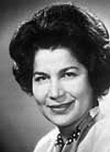
On Oct. 6, 1971 the Los Angeles Times reports that federal agents had caught 36 illegal immigrants in a raid on the Ramona's Mexican Food Products food processing plant owned by Romana Acosta Banuelos (Bañuelos) (1925-), who had three weeks earlier been named by Pres. Nixon to be treasurer of the U.S.; Nixon orders the income tax returns of Los Angeles Times publisher Otis Chandler audited; Banuela serves as U.S. treasurer #34 from Dec. 17 through May 8, 1974. becoming the first Hispanic.





The Watergate break-in becomes the Democrats' Big Silver Bird? On June 17, 1972 (Sat.) (2:00 a.m.) the Watergate Scandal begins when five men are arrested by D.C. police for breaking into the Dem. Nat. Committee HQ in the Watergate Complex in Foggy Bottom, Washington, D.C. (built in 1967), on the Georgetown Channel not far from the White House at the intersection of Virginia Ave., New Hampshire Ave., and Rock Creek & Potomac Pkwy. after black night watchman Frank Wills (1948-2000) finds and removes some duct tape from a door lock, returns and finds it put back, the calls police; the arrested Watergate Burglars incl. Bernard Leon Barker (1917-2009) (ex-member of the Batista Cuban secret police) (the fake Secret Service agent on the Grassy Knoll in Dallas on Nov. 22, 1963?), electronics expert James Walter McCord Jr. (1924-), Eugenio R. "Musculito" Martinez (1924-) (Cuban), Frank Anthony Sturgis (Fiorini) (1924-93) (Am. who worked in Cuba), and Virgilio R. Gonzalez (1926-) (Cuban), who are carrying cameras and electronic surveillance equipment (their 2nd break-in, with the mission of removing bugs they had placed the 1st time); on June 17 after being put up to it by Jeb Stuart Magruder (1934-), deputy dir. of the Committee to Re-Elect the President (CREEP), who was put up to it by former U.S. atty.-gen. #67 (1969-72) John Newton Mitchell (1913-88) (chmn. of CREEP, Nixon's campaign mgr., and WWII cmdr. of JFK's PT boat unit), former FBI agent and atty. George Gordon Battle Liddy (1930-) (mastermind of the burglary, who supervised it from a hotel across the street) approaches U.S. atty.-gen. #68 (1972-3) Richard Gordon Kleindienst (1923-2000) (born in Winslow, Ariz.) at a private golf club in Bethesda, Md. and asks him to get the burglars released and to help coverup that it traces to CREEP, and although he doesn't get them released, he also fails to rat on them, which would have broken the case open for the public, causing him to hang on until Nixon fires him as a patsy; on June 19 Mitchell says that they were not "operating either on our behalf or with our consent"; on June 19 White House press secy. Ronald Louis Ziegler calls the break-in a "third-rate burglary"; the scandal begins after CREEP and White House consultant Everette Howard Hunt (1918-2007), consultant to pres. special counsel (1969-73) Charles Wendell "Chuck" Colson (1931-2012) until Mar. 29, and known for directing CIA activities against Fidel Castro are linked to the burglars, starting with Hunt's number being found in the burglars' address books, with the White House admitting that Hunt met Barker earlier in June; on June 20 Nixon tells Colson that he has a "dangerous job"; Hunt, Liddy, and Seattle, Wash. atty. Egil "Bud" Krogh Jr. (1939-) later reveal that they were created in June-July 1971, and named the White House Plumbers by Henry Kissinger's former aide David Young (1936-) for their work in plugging leaks, and claim that Hunt recruited four of the five burglars (except McCord) from a team who worked on the Bay of Pigs invasion in order to see if Castro was making contributions to the McGovern campaign; meanwhile Washington Post reporters Bob Woodward (1943-) and Carl Bernstein (1944-), working for "Woodstein!"-shouting ed.-in-chief (1965-91) Benjamin Crowninshield "Ben" Bradlee (1921-2014) and publisher Katharine Graham (1917-2001) are assigned to the arraignment of the Watergate burglars, after which they meet with mysterious govt. figure "Deep Throat", deputy FBI dir. William Mark Felt Sr. (1913-2008) (who keeps his identity secret until 2005), who tells them to "follow the money", and makes Woodward stick a red flag in his balcony flower pot to request meetings, and they soon lock-on to the trail leading straight to the Oval Office, causing every political scandal in the U.S. to be tokenized into some kind of "-gate"; on Aug. 30, 2016 the CIA document Working Draft - CIA Watergate History is declassified, revealing that Eugenio Martinez was "actively being paid by the CIA at the time of the arrests on June 17, 1972" to do the break-in.
On Feb. 16, 1973 after it crusades to get more money for victims, causing the atty.-gen. to seek an injunction to silence it an article schedule for Sept. 1972, the British court of appeals rules that the weekly Sunday Times can pub. articles on Thalidomide and its maker Distillers Co. despite legal actions by parents; too bad, in July the House of Lords overturns the decision, claiming that freedom of the press is contempt of court, "A generic term descriptive of conduct in relation to particular proceedings in a court of law which tends to undermine that system or to inhibit citizens from availing themselves of it for the settlement of their disputes"; on Apr. 26, 1979 the European Court of Human Rights rules 11-9 that the British govt. violated Article 10 of the Convention for the Protection of Human Rights and Fundamental Freedoms.
On Feb. 20, 1974 Atlanta Constitution ed. J. Reginald "Reg" Murphy (1933-) is kidnapped by a group calling itself the Am. Rev. Army; he is released unharmed on Feb. 24 after his newspaper pays a $700K ransom.
On Mar. 4, 1974 50 women's groups from three states picket the New York Times to protest its refusal to bow to their demands to use the designations "Ms.", "spokesperson", "chairperson" et al., and to give more coverage to women's news; they don't bow to their demands until the 1980s, bringing up the rear among major newspapers.

On July 11, 1974 Knight-Ridder Newspapers are created by John Shively Knight (1894-1981) (owner of the Miami Herald since 1937) from a merger of his 15-paper Ridder chain (founded 1892) the 16-paper Ridder chain,, becoming the largest newspaper publisher in the U.S.; "Newspapers" is removed from the name in 1976; in 1982 it launches the Viewtron videotex system, only to shut it down in 1986 when it becomes more popular than the newspaper.
On July 26,1974 Peruvian pres. Juan Velasco Alvarado expropriates Peru's #1 newspaper La Prensa (The Press), which has been owned since 1934 by former finance minister (1959-61) Pedro Gerado Beltran (1897-1979); it stays govt.-controlled until the restoration of democracy in 1980.
In 1974 employees of the South Korean newspaper Dong-A Ilbo strike to protest the planting of Korean Central Intelligence Agency (KCIA) agents in their offices, and pres. Park Chung-hee withdraws them under pressure then orders a commercial advertising boycott, almost forcing it into bankruptcy until intellectuals and blue-collar workers unite to buy advertising.

On July 4, 1975 Australian newspaper publisher Juanita Joan Nielsen (b. 1937) (known for campaigning against corruption and development) disappears in Sydney, and is presumed to have been murdered, becoming the subject of the 1981 film The Killing of Angel Street.

On Sept. 29, 1980 the Washington Post pub. Jimmy's World, about an 8-y.-o. "third-generation heroin addict, a precocious little boy with sandy hair, velvety brown eyes, and needle marks freckling the baby-smooth skin of his thin brown arms" by Janet Leslie Cooke (1954-), which later turns out to be fiction after she is awarded a Pulitzer Prize on Apr. 13, 1981 and fesses up on Apr. 15, returning it and embarrassing her newspaper, who fires her, ending her journalistic career - can I change the category and still keep the prize?
On Oct. 1, 1980 AP announces that the London Evening News will close and merge with the London Evening Standard (founded May 21, 1827), becoming the #1 evening paper for the London area; in Oct. 2009 it becomes free, doubling circ.

On Sept. 15, 1982 Gannett's USA Today ("the McPaper"), a full-color newspaper with condensed news for the decreasingly literate public begins pub. (until ?), founded by Eureka, S.D.-born Allen Harold "Al" Neuharth (1924-2013), becoming the only U.S. nat. daily other than Christian Science Monitor and Wall Street Journal, reaching 362,879 circ. by the end of the year, 1.4M by the end of 1985, and 5.5M by 1987; it doesn't turn a profit until 1993.
On Apr. 15, 1984 the New York Times pub. its last "Shipping/Mails" column as passenger volume dwindles to 400K from 900K in 1960, and most arrivals are cruise ships not passenger liners.
On July 13, 1995 the Detroit, Mich. Newspaper Strike begins, with 2.5K members of six labor unions, ending on Feb. 14, 1997, after which it goes to court and the journalists' union losing its unfair labor practices case on appeal.

On Apr. 18, 1997 the 7-story 250K sq. ft. Newseum at 555 Pennsylvania Ave. NW in Washington, D.C. opens as a shrine to journalism and the U.S. First Amendment, attracting 815K visitors/year, losing money despite high admission fees; on Jan. 25, 2019 Johns Hopkins U. announces plans to buy it for $372.5M for graduate programs.


In Sept. 2005 Brooklyn, N.Y.-born gay billionaire DreamWorks SKG co-founder David Lawrence Geffen (1943-) begins discussing the purchase of the Los Angeles Times with Leo Wolinsky, making a $2B offer in Nov. 2006, which the parent Tribune Co. rejects, selling instead in Dec. 2007 to Chicago billionaire real estate tycoon Samuel Zell (Shmuel Zielonka) (1941-), who also acquires the Chicago Tribune and Chicago Cubs ML baseball team.

On Apr. 2, 2007 Am. Jewish billionaire Sam Zell (1941-) buys the Tribune Co., incl. the Chicago Tribune and Los Angeles Times, promising to sell the Chicago Cubs; after he institutes stringent financial controls, the Washington Post disses him in June 2008, calling him "The L.A. Times' Human Wrecking Ball", "well on his way to... destroying the L.A. Times", equating him to 1910 L.A. Times bomber James McNamara and concluding "Life in San Quentin sounds about right" for him.

On June 28, 2018 (2:34 p.m. local time) a shooter at the Capital Gazette Newspaper Bldg. in Annapolis, Md. kills five incl. four journalists and a salesperson and injures several others; suspect Jarrod Warren Ramos (1979-) surrenders and is arrested.